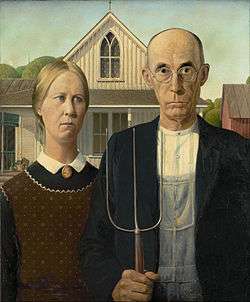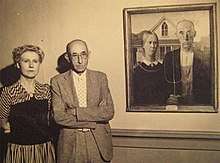American Gothic
American Gothic is a 1930 painting by Grant Wood in the collection of the Art Institute of Chicago. He was inspired to paint what is now known as the American Gothic House in Eldon, Iowa, along with "the kind of people [he] fancied should live in that house". It depicts a farmer standing beside his daughter – often mistakenly assumed to be his wife.[1][2] The painting is named for the house's architectural style.
| American Gothic | |
|---|---|
 | |
| Artist | Grant Wood |
| Year | 1930 |
| Type | Oil on beaverboard |
| Dimensions | 78 cm × 65.3 cm (30 3⁄4 in × 25 3⁄4 in) |
| Location | Art Institute of Chicago |
The figures were modeled by Wood's sister Nan Wood Graham and their dentist Dr. Byron McKeeby. The woman is dressed in a colonial print apron evoking 20th-century rural Americana while the man is adorned in overalls covered by a suit jacket and carries a pitchfork. The plants on the porch of the house are mother-in-law's tongue and beefsteak begonia, which also appear in Wood's 1929 portrait of his mother, Woman with Plants.[3]
American Gothic is one of the most familiar images of 20th-century American art and has been widely parodied in American popular culture.[1][4] From 2016–17, the painting was displayed in Paris at the Musée de l'Orangerie and in London at the Royal Academy of Arts in its first showings outside the United States.[5][6][7]
Creation

In August 1930, Grant Wood, an American painter with European training, was driven around Eldon, Iowa, by a young local painter named John Sharp. Looking for inspiration, he noticed the Dibble House, a small white house built in the Carpenter Gothic architectural style.[8] Sharp's brother suggested in 1973 that it was on this drive that Wood first sketched the house on the back of an envelope. Wood's earliest biographer, Darrell Garwood, noted that Wood "thought it a form of borrowed pretentiousness, a structural absurdity, to put a Gothic-style window in such a flimsy frame house".[9]

At the time, Wood classified it as one of the "cardboardy frame houses on Iowa farms" and considered it "very paintable".[10] After obtaining permission from the house's owners, Selma Jones-Johnston and her family, Wood made a sketch the next day in oil paint on paperboard from the front yard. This sketch depicted a steeper roof and a longer window with a more pronounced ogive than on the actual house – features which eventually adorned the final work.
Wood decided to paint the house along with, in his words, "the kind of people [he] fancied should live in that house".[1] He recruited his sister, Nan (1899–1990), to be the model for the daughter, dressing her in a colonial print apron mimicking 20th-century rural Americana. The model for the father was the Wood family's dentist,[11] Dr. Byron McKeeby (1867–1950) from Cedar Rapids, Iowa.[12][13] Nan told people that her brother had envisioned the pair as father and daughter, not husband and wife, which Wood himself confirmed in his letter to a Mrs. Nellie Sudduth in 1941: "The prim lady with him is his grown-up daughter."[1][14]
Elements of the painting stress the vertical that is associated with Gothic architecture. The three-pronged pitchfork is echoed in the stitching of the man's overalls, the Gothic window of the house, and the structure of the man's face.[15] However, Wood did not add figures to his sketch until he returned to his studio in Cedar Rapids.[16] Moreover, he would not return to Eldon again, although he did request a photograph of the home to complete his painting.[8]
Reception and interpretation
Wood entered the painting in a competition at the Art Institute of Chicago. One judge deemed it a "comic valentine", but a museum patron persuaded the jury to award the painting the bronze medal and a $300 cash prize.[17] The same patron also persuaded the Art Institute to buy the painting, and it remains part of the Chicago museum's collection.[2] The image soon began to be reproduced in newspapers, first by the Chicago Evening Post, and then in New York, Boston, Kansas City, and Indianapolis. However, when the image finally appeared in the Cedar Rapids Gazette, there was a backlash. Iowans were furious at their depiction as "pinched, grim-faced, puritanical Bible-thumpers".[18] Wood protested, saying that he had not painted a caricature of Iowans but a depiction of his appreciation, stating "I had to go to France to appreciate Iowa."[11] In a 1941 letter, Wood said that, “In general, I have found, the people who resent the painting are those who feel that they themselves resemble the portrayal. [19]
American art historian Wanda M. Corn insists that Wood was not painting a modern couple, but rather one of the past, pointing to the fact that Wood directed the models to wear old-fashioned clothing which he found inspiration for by consulting his family photo album. Wood even posed the figures in a way that resembled long-exposure photographs of Midwestern families that dated before World War I [20].
Art critics who had favorable opinions about the painting, such as Gertrude Stein and Christopher Morley, similarly assumed the painting was meant to be a satire of rural small-town life. It was thus seen as part of the trend toward increasingly critical depictions of rural America along the lines of, in literature, Sherwood Anderson's 1919 novel Winesburg, Ohio, Sinclair Lewis's 1920 Main Street, and Carl Van Vechten's 1924 The Tattooed Countess.[1]
However, with the onset of the Great Depression not too long after the painting was made, American Gothic came to be seen as a depiction of the steadfast American pioneer spirit. Wood assisted this interpretive transition by renouncing his Bohemian youth in Paris and grouping himself with populist Midwestern painters such as John Steuart Curry and Thomas Hart Benton, who revolted against the dominance of East Coast art circles. Wood was quoted in this period as stating, "All the good ideas I've ever had came to me while I was milking a cow."[1]
in 2005, art historian Sue Taylor offered suggested that the figures in the portrait may actually be Wood’s parents. She claimed that due to Wood's father passing away when Wood was only ten years old, Wood did not develop a close relationship with him but noted that he did spend the rest of his life very closely attached to his mother. She theorizes that Wood may have developed an Oedipus complex and subconsciously expressed that in the painting. Taylor cites the lack of warmth between the two figures as well as Wood's classification of them as “father and daughter” was a way for Wood to remove any sexual connotation so that Wood wouldn't have to face his own fears and insecurities. Taylor also points out similarities between other portraits of Wood’s mother and the woman in American Gothic, including the broach that she wears. [21]
In 2010, art historian Tripp Evans of Wheaton College interpreted it as an "old-fashioned mourning portrait ... Tellingly, the curtains hanging in the windows of the house, both upstairs and down, are pulled closed in the middle of the day, a mourning custom in Victorian America. The woman wears a black dress beneath her apron, and glances away as if holding back tears. One imagines she is grieving for the man beside her". Wood had been only 10 when his father died, and later he lived for a decade "above a garage reserved for hearses", so death was probably on his mind.[22]
In 2019, culture writer Kelly Grovier described it as a portrait of Pluto and Proserpina, the Roman gods of the underworld.[23]
Parodies and other references
The Depression-era understanding of the painting as depicting an authentically American scene prompted the first well-known parody, a 1942 photo by Gordon Parks of cleaning woman Ella Watson, shot in Washington, D.C.[1]
American Gothic is a frequently parodied image. It has been lampooned in Broadway shows such as The Music Man, movies such as The Rocky Horror Picture Show, and television shows such as Green Acres (in the final scene of the opening credits) and the Dick Van Dyke Show ("The Masterpiece" episode). It has also been parodied in marketing campaigns, pornography, and by couples who recreate the image photographically by facing a camera in the same way, one of them holding a pitchfork or other object in its place.[1][4]
 American Gothic, Washington, D.C., 1942, by Gordon Parks was the first prominent parody of the painting.
American Gothic, Washington, D.C., 1942, by Gordon Parks was the first prominent parody of the painting. Visitors dress up for a photograph outside the American Gothic House in Eldon, Iowa.
Visitors dress up for a photograph outside the American Gothic House in Eldon, Iowa.
See also
References
- Fineman, Mia (June 8, 2005). "The Most Famous Farm Couple in the World: Why American Gothic still fascinates". Slate.
- "About This Artwork: American Gothic". The Art Institute of Chicago. Archived from the original on 28 May 2010. Retrieved June 20, 2010.
- "The Painting". American Gothic House. Archived from the original on 2014-11-29. Retrieved 2015-01-08.
- Güner, Fisun (8 February 2017). "How American Gothic became an icon". BBC. Retrieved 2 March 2017.
- Cumming, Laura (5 February 2017). "American Gothic: a state visit to Britain for the first couple". The Guardian. Retrieved 2 March 2017.
- "American Painting in the 1930's: Musée de l'Orangerie". musee-orangerie.fr. Archived from the original on 26 October 2017. Retrieved 2 March 2017.
- Artwork 6565 Art Institute of Chicago
- "American Gothic House Center". Wapello County Conservation Board. Archived from the original on June 18, 2009. Retrieved July 14, 2009.
- Garwood, p. 119
- Quoted in Hoving, p. 36
- Semuels, Alana (April 30, 2012). "At Home in a Piece of History". Los Angeles Times. Retrieved February 25, 2013.
- "Dr. Byron McKeeby's contribution to Grant Wood's 'American Gothic'"
- "The models for American Gothic". Archived from the original on 2015-01-06. Retrieved 2015-01-08.
- "Grant Wood's Letter Describing American Gothic". Campsilos.org. Retrieved 2010-04-12.
- "Grant Wood's American Gothic". Smarthistory at Khan Academy. Retrieved December 18, 2012.
- Quoted in Biel, p. 22
- Biel, Steven (2005). American Gothic: A Life of America's Most Famous Painting. W. W. Norton & Company. p. 28. ISBN 978-0-393-05912-0.
- Andréa Fernandes. "mental_floss Blog » Iconic America: Grant Wood". Mentalfloss.com. Archived from the original on 2009-02-15. Retrieved 2010-04-12.
- "Grant Wood's Letter Describing American Gothic". www.campsilos.org. Retrieved 2020-06-30.
- Corn, Wanda M.; Wood, Grant (1983). "The Birth of a National Icon: Grant Wood's "American Gothic"". Art Institute of Chicago Museum Studies. 10: 252. doi:10.2307/4104340.
- Taylor, Sue (2005). "Grant Wood's Family Album". American Art. 19 (2): 48–67. doi:10.1086/444481. ISSN 1073-9300.
- Deborah Solomon (October 28, 2010). "Gothic American". The New York Times.
- "How Science and Tech Left an Imprint on 3 Iconic Paintings", Kelly Grovier, Wired, January 9, 2019. Excerpted from A New Way of Seeing: The History of Art in 57 Works ISBN 978-0500239636
Sources
- Garwood, Darrell (1944). Artist in Iowa: A Life of Grant Wood. New York: W. W. Norton & Company. OCLC 518305.
- Hoving, Thomas (2005). American Gothic: The Biography of Grant Wood's American Masterpiece. New York: Chamberlain Bros. ISBN 978-1-59609-148-1.
- Girod, André (2014). American Gothic: une mosaïque de personnalités américaines (in French). Paris: L'Harmattan. ISBN 978-2-343-04037-0.
Further reading
- Howard, Beth M. (2018-03-18). "Masterpiece Rental: My Life in the 'American Gothic' House". The New York Times. ISSN 0362-4331. Retrieved 2018-04-05. (contains image of first Wood sketch of the house)
External links
 | |
- Grant Wood and Frank Lloyd Wright Compared
- About the painting, on the Art Institute's site
- Slate article about American Gothic
- American Gothic, French
- American Gothic: A Life of America's Most Famous Painting
- Television Commercials (1950s-1960s) contains General Mills New Country Corn Flakes commercial
- American Gothic sculpture removed from Michigan Avenue
- American Gothic Parodies collection
- November 18, 2002, National Public Radio Morning Edition report about American Gothic by Melissa Gray that includes an interview with Art Institute of Chicago curator Daniel Schulman.
- June 6, 1991, National Public Radio Morning Edition report on Iowa's celebration of the centennial of Grant Wood's birth by Robin Feinsmith. Several portions of the report focus on American Gothic.
- February 13, 1976, National Public Radio All Things Considered Cary Frumpkin interview with James Dennis, author of Grant Wood: A Study in American Art and Culture. The interview contains a discussion about American Gothic.